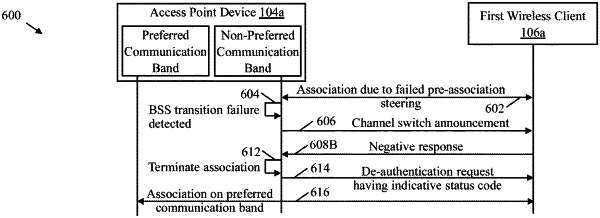| CPC H04W 72/52 (2023.01) [H04W 48/20 (2013.01); H04W 72/0453 (2013.01)] | 17 Claims |

|
1. An access point device operable in a wireless network, the access point device comprising:
processing circuitry configured to:
detect multi-band capability of a first wireless client that attempts to associate on a non-preferred communication band of the access point device by transmitting a first probe request to the access point device on the non-preferred communication band, wherein the processing circuitry detects the multi-band capability of the first wireless client based on a set of parameters included in the first probe request; block the attempt of the first wireless client to associate on the non-preferred communication band based on the detected multi-band capability of the first wireless client;
allow the first wireless client to associate with the access point device on one of the non-preferred communication band and a preferred communication band of the access point device based on a count of probe requests received by the processing circuitry from the first wireless client on the non-preferred communication band;
while being associated with the first wireless client on the non-preferred communication band, determining via the non-preferred communication band a Basic Service Set (BSS) transition capability of the first wireless client associated with the access point device; and steering the first wireless client to the preferred communication band of the access point device based on the BSS transition capability;
transmit, based on a failure in the BSS transition or the first wireless client not having the BSS transition capability, an extended channel switch announcement (ECSA) to the first wireless client; receive a negative response to the extended channel switch announcement from the first wireless client, send a de-authentication request to the first wireless device to force a re-connect of the first wireless client on the preferred communication band in response to the negative response to the extended channel switch announcement,
wherein if the first wireless client does not associate on the preferred communication band after a configured number of attempts to force the re-connect, allowing the first wireless client to remain connected to the non-preferred band, wherein the attempts are performed after the negative response to the extended channel switch announcement and to one or more de-authentication requests, and after the first wireless client was associated with the access point on the non-preferred band; and
in response to determining that the set of parameters included in the first probe request does not indicate that the first wireless client has multi-band capability, allowing the first wireless client to associate with the access point on the non-preferred communication band.
|